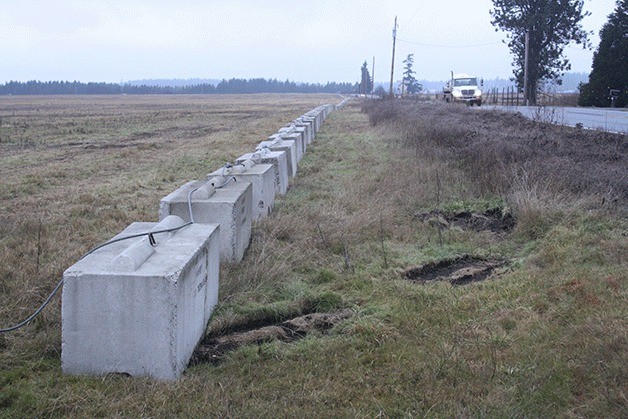A state agency reversed its determination about cement blocks placed at Outlying Field Coupeville, saying that they, in fact, have an “adverse effect” to the historic landscape of neighboring Ebey’s Landing National Historic Reserve.
More than 1,000 cement barriers were installed earlier this month at the Navy’s outlying field, part of Whidbey Island Naval Air Station.
The Navy uses OLF Coupeville for touch-and-go operations for the EA-6B Prowler and EA-18G Growler.
The Navy said it is also planning to install fencing at the entryways.
While the state Department of Archaeology and Historic Preservation initially issued a “no adverse effect” determination in September, the office retracted its statement last week citing “new information about the project.”
After receiving questions from the public, the project was reviewed, said Allyson Brooks, the state historic preservation officer.
It was found that, while the Navy addressed archaeological concerns, it did not address affects the blocks may have on the historical nature of the area.
Under the National Historic Preservation Act, or NHPA, projects involving national parks like Ebey’s Reserve must be reviewed by the state Historic Preservation Officer.
“Clearly the Navy consulted the state archaeologist but did not consider the effects to the historic landscape,” Brooks said.
Whether the blocks will be permanent is also a concern, according to Brooks.
In correspondence to the state historic preservation officer’s office, Kendall Campbell, archaeologist and cultural resources program manager, said that the blocks are a temporary fix to address OLF’s security issues.
“Ebey’s Reserve is adjacent to the northern boundary of OLF Coupeville,” Campbell said. “Since the concrete blocks are short (less than 3 feet high) and easily removed, they do not permanently impact the ‘viewshed’ of Ebey’s Reserve or historic properties (like a solid fence, for example).”
“The blocks are a temporary solution to a long identified security risk at OLF,” Campbell said.
A more permanent solution to the airfield’s security issues would be treated as a separate undertaking, requiring a “more robust NEPA” process, said Campbell.
A “no adverse effect” determination was sufficient for this type of barrier for up to five years, Brooks said.
However, when the Navy was unable to furnish a solid time frame for the blocks, she said she factored this into her decision to reverse the determination.
“For a period of longer than five years we contend that the visual impacts to the historic Ebey’s landscape will alter the characteristics that make the area nationally significant,” Brooks said in her determination letter.
Because Brooks concluded that the project has an “adverse effect,” the Navy now moves into mitigation with the state agency, during which additional organizations will be consulted to determine a solution.
A Memorandum of Agreement will need to be drafted with the agreement of all affected parties.
“The base’s cultural resources program manager continues to consult with the state on these projects, as well as with the National Park Service and the Ebey’s Landing National Historical Reserve,” said Mike Welding, public affairs officer for NAS Whidbey.
Citizens of Ebey’s Reserve, or COER, is calling for an immediate removal of the cement blocks at OLF.
COER is a citizen group seeking closure of OLF Coupeville because of noise.
“The shame is that none of this needed to occur if only the Navy had followed the rules established to protect the public,” said Michael Monson, COER president.
“By making this decision to put a cement barrier wall at OLF, where the Navy had cut down a historically significant hedgerow barrier that had served security purposes for years, the Navy ignored the intent of the National Historic Preservation Act, as well as local civilian processes and procedures as published on the town of Coupeville’s website listed under Ebey’s Reserve’s building guidelines.”
Bill MacMillan, NAS Whidbey airfield manager, said he has proposed additional security at OLF since he took the position in 2005, but it took a drunk driver to cause damage to OLF’s arresting gear in 2007 to raise the priority of the project.
Some blocks were put into place in 2009, but Navy officials said NAS Whidbey recently received funding to complete the project this year.
Brooks released a questions and answers document Thursday in response to “so many records requests for the OLF project.”
The Department of Historic Preservation does not have approval over Navy actions, Brooks states, but does make the “initial determination on the effects of their undertakings on historic properties.”
It is incumbent on the Navy and other federal agencies to consult with her office, federally recognized tribes and other consulting parties based on size and controversy, Brooks said.
Brooks defines a consulting party as an individual or organization who would have some duties or participation under a Memorandum of Agreement.
These could include Ebey’s Landing Trust Board or the National Park Service or the Island County Commissioners.
The public can get involved when an adverse effect is determined “and/or there is sufficient public controversy.”
Brooks added that the Navy should have a public meeting about this undertaking under Section 106 of the NHPA.
“Ultimately it is the decision of the federal agency, but should they refuse we will consult with the Federal Advisory Council on Historic Preservation,” Brooks said. “The agency can, however, refuse to have a public meeting and just request public comments. We would prefer a meeting that is strictly moderated.”



